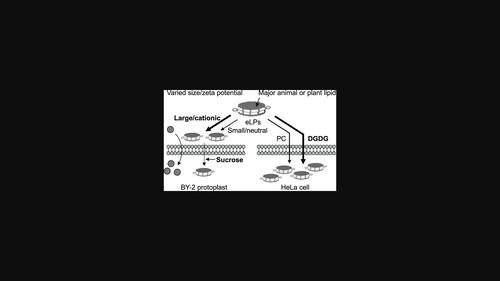当前位置:
X-MOL 学术
›
Genes Cells
›
论文详情
Our official English website, www.x-mol.net, welcomes your feedback! (Note: you will need to create a separate account there.)
Effects of lipoprotein nanoparticles' composition and size on their internalization in plant and mammalian cells
Genes to Cells ( IF 2.1 ) Pub Date : 2023-10-18 , DOI: 10.1111/gtc.13075 Ryosuke Fukuda 1, 2 , Misaki Tani 2, 3 , Shiori Shibukawa 2, 3 , Tomohiro Nobeyama 2, 3 , Taiji Nomura 2, 3 , Yasuo Kato 2, 3 , Tatsuya Murakami 1, 2, 3, 4
Genes to Cells ( IF 2.1 ) Pub Date : 2023-10-18 , DOI: 10.1111/gtc.13075 Ryosuke Fukuda 1, 2 , Misaki Tani 2, 3 , Shiori Shibukawa 2, 3 , Tomohiro Nobeyama 2, 3 , Taiji Nomura 2, 3 , Yasuo Kato 2, 3 , Tatsuya Murakami 1, 2, 3, 4
Affiliation

|
The internalization of engineered high-density lipoprotein nanoparticles (engineered lipoproteins [eLPs]) with different lipid and protein compositions, zeta potentials, and/or sizes were analyzed in representative plant and mammalian cells. The impact of the addition of a cell-penetrating peptide to eLPs on the internalization was very small in Bright Yellow (BY)-2 protoplasts compared with HeLa cells. When eLPs were prepared with one of the abundant lipids in BY-2 cells, digalactosyldiacylglycerol (DGDG) (eLP4), its internalization was dramatically increased only in HeLa cells. Such an increase in HeLa cells was also obtained for liposomes containing DGDG in a DGDG content-dependent manner. Increasing the size and zeta potential of eLPs improved their internalization in both HeLa cells and in BY-2 protoplasts but to quite varying degrees. Although eLPs tended to stay at the plasma membrane (PM) in BY-2 protoplasts with much less internalization, the PM-bound eLPs somehow promoted the internalization of coexisting nanobeads in cell culture media. These results provide fundamental insight into the future design of lipid nanoparticles for drug delivery in mammalian and plant cells.
更新日期:2023-10-18



























 京公网安备 11010802027423号
京公网安备 11010802027423号